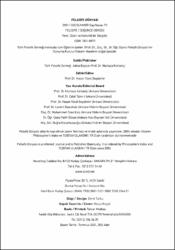| dc.contributor.author | Avcı, Nil | |
| dc.date.accessioned | 2022-04-02T19:23:50Z | |
| dc.date.available | 2022-04-02T19:23:50Z | |
| dc.date.issued | 2021 | en_US |
| dc.identifier.citation | Avcı, N. (2021). Nietzsche’de estetik kurtuluş. Felsefe Dünyası, 1 (73), 267-293. Erişim adresi: https://dergipark.org.tr/tr/pub/felsefedunyasi/issue/64193/973359 | en_US |
| dc.identifier.issn | 1301-0875 | |
| dc.identifier.uri | https://hdl.handle.net/20.500.12712/33056 | |
| dc.description.abstract | Eğer var olmak zorunlu olarak acıyı beraberinde getiriyorsa, hiç var olmamış olmak yada yok olmak daha arzulanası değil midir? Nietzsche’nin bu soruya olumsuz cevap vermeçabası ilk metinlerindeki dünyanın kurtuluşu (Welt-Erlösung) ya da varoluşun haklılandırılması (Rechtfertigung des Daseins) düşüncesinden başlanarak son yıllarındaki yaşama“evet” deme ya da yaşamı olumlama (Bejahung des Lebens) çağrısına değin takip edilebilir.Bu çaba yaşamın ve yaşama içkin tüm acının yaşanmaya değer olduğunu gösterme, onuhiçliğin karşısında haklı çıkarma çabasıdır. Bu çalışmanın amacı Tragedyanın Doğuşu’nda(Die Geburt der Tragödie) Nietzsche’nin varoluşu savunmak için estetik deneyimi ve estetikdeğerleri nasıl kullandığını çözümlemektir. Bu amaç doğrultusunda eserin estetik kurtuluş kavramı üzerinden bir okuması sunulacaktır. Eserde varoluşun değeri meselesi birduygu meselesi olarak karşımıza çıkarken bu duyguyu yaşatacak olanın yalnızca estetikdeneyim olduğunu görürüz. Estetik deneyimin nesnel boyutunu, başka bir deyişle, neyindeneyimlendiğini anlayabilmek için ise Nietzsche’nin sanatçılar-metafiziği (Artisten-Metaphysik) olarak adlandırdığı metafizik kuramını incelememiz gerekecektir. | en_US |
| dc.description.abstract | If to exist necessarily means to suffer, is it not the case that not to have been existed or to stop existing is much more desirable than to exist? Nietzsche’s struggle to respond this question in a negative way can be traced by starting from his notions of salvation of the word (Welt-Erlösung) or of justification of existence (Rechtfertigung des Daseins) in his early works, to the call of saying Yes to life or of affirmation of life (Bejahung des Lebens) in his late years. This struggle is to justify that life and all the pain immanent to it is worth to live, to defend existence against the nothingness. The aim of this study is to analyze how Nietzsche uses aesthetic experience and aesthetic values to justify existence in The Birth of Tragedy (Die Geburt der Tragödie). With this aim, an interpretation of this work from the perspective of to the notion of aesthetic salvation is going to be presented. While in the work the problem of the value of existence is encountered as the problem of feeling, the only experience through which this feeling can arise will be given as aesthetic experience. To comprehend the objective side of aesthetic experience, in other words, to comprehend that which is experienced, we will have to examine the metaphysical theory which Nietzsche calls artists-metaphysics (Artisten-Metaphysik). | en_US |
| dc.language.iso | tur | en_US |
| dc.publisher | Türk Felsefe Derneği | en_US |
| dc.rights | info:eu-repo/semantics/openAccess | en_US |
| dc.subject | modernizm | en_US |
| dc.subject | hiççilik | en_US |
| dc.subject | estetik deneyim | en_US |
| dc.subject | estetik kurtuluş | en_US |
| dc.subject | tragedya | en_US |
| dc.subject | modernism | en_US |
| dc.subject | nihilism | en_US |
| dc.subject | aesthetic experience | en_US |
| dc.subject | aesthetic salvation | en_US |
| dc.subject | tragedy | en_US |
| dc.title | Nietzsche’de estetik kurtuluş | en_US |
| dc.title.alternative | Aesthetic salvation in Nietzsche | en_US |
| dc.type | article | en_US |
| dc.contributor.department | OMÜ, Fen-Edebiyat Fakültesi, Felsefe Bölümü | en_US |
| dc.contributor.authorID | 0000-0002-5989-5895 | en_US |
| dc.contributor.institutionauthor | Avcı, Nil | |
| dc.identifier.volume | 1 | en_US |
| dc.identifier.issue | 73 | en_US |
| dc.identifier.startpage | 267 | en_US |
| dc.identifier.endpage | 293 | en_US |
| dc.relation.journal | Felsefe Dünyası | en_US |
| dc.relation.publicationcategory | Makale - Ulusal Hakemli Dergi - Kurum Öğretim Elemanı | en_US |
















